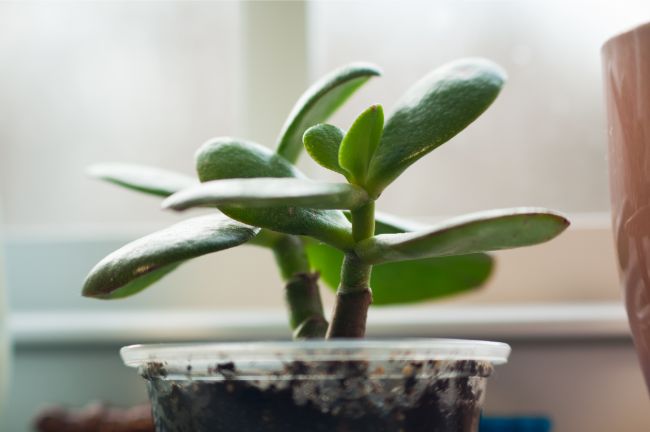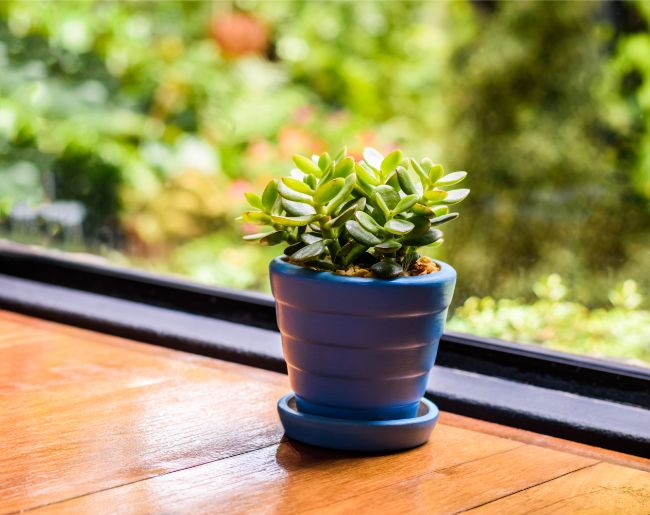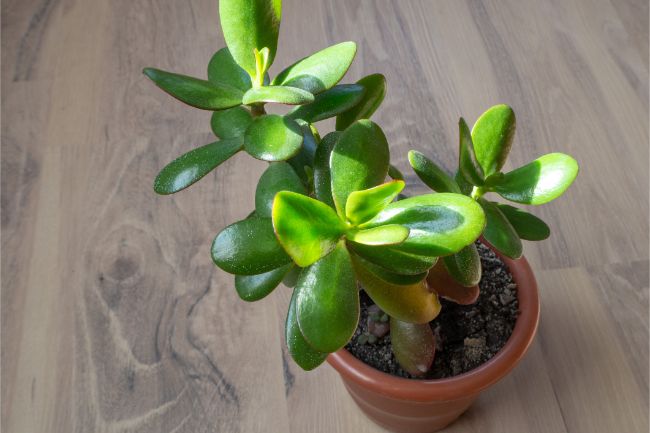Seeing white spots appear on the leaves or stem of your jade plant (Crassula ovata) can be concerning. White spots on jade plants are a common sight and can spoil the look of an otherwise beautiful plant. Thankfully, identifying and effectively treating the cause is easier than you think.
Why does my jade plant have white spots? The main reasons jade plants have white spots include mold growth such as powdery mildew, excess salt excretion or an insect infestation. Each of these causes can be identified and treated by following a few simple steps.
Identifying the cause of the white spots on your jade plant requires a bit of know-how. This guide aims to break down important information, to help you get your jade back to an optimal state. Recognizing the core issue and applying effective remedies is easy if you know the information below.
I’ve also written a detailed jade plant care guide, that covers all aspects of growing a healthy jade plant, including care conditions, pruning and propagation, so take a look if you’d like to learn more.
1. Powdery Mildew Causes White Spots On Jade Plants
Powdery mildew can be a reason why you see white spots on your jade plant. This white mold is a fungal disease that commonly affects a variety of houseplants.
When this fungus first starts to grow, it produces small white circular spots on the broadest parts of the plant. For the jade plant, these spots first appear on the leaf foliage. At later stages, powdery mildew can be identified by the fluffy fungal strings that spread along other parts of the plant.
If you take into consideration the physical look of powdery mildew but still aren’t sure if that’s why you see white spots on your jade plant, take into account your plant’s environment.
Growth of powdery mildew is common in low light conditions, low air circulation, cool temperatures and high humidity. If you see white spots and your plant is in a habitat with these features, then the spots are likely powdery mildew.
Powdery Mildew Remedy For Jade Plants
If you can see that the powdery mildew is at an early stage, treatment should be fairly easy and your plant is unlikely to have come to any harm. A popular home remedy to spray on the leaves of your jade plant is comprised of one tablespoon baking soda, one teaspoon of non-detergent soap combined with one gallon of water.
This can be used on a daily basis, if you continue to see white spots reappearing. Powdery mildew produces spores that you can’t see, and this spray keeps them under control.
There are a number of other good natural remedies to get rid of powdery mildew. I’ve written an article covering all the options in this article.
2. Excess Salts Can Cause White Spots On Jade Plants
Jade plants are succulents that stores the majority of their water in their fleshy leaves. When watered with a source that’s high in salt content, the moisture in the leaves will become imbalanced. This can sometimes cause you to see white spots on jade plants.
When the jade plant tries to re-balance the salt content in leaves, it transpires and eliminates salt through the leaf pores. Then, the salt water will evaporate and leave a salt residue on the leaf.
Unfortunately, this white spot looks very similar to the beginning stages of powdery mildew. Overhead watering can also cause spots to appear on the leaves of your jade plant, as the excess water evaporates, leaving the salt deposits on the leaves.
The easiest way to tell the difference between a fungal infection and excess salts is to wipe the leaves off with a damp cloth and wait a week. If the spots recur rapidly and start to look like fluffy fungus, it is likely powdery mildew. Salt deposits take longer to reappear.

3. Insect Infestation Causes White Spots On Jade Plants
Stress from an insect infestation could cause chlorosis in your jade plant. Chlorosis occurs when a plant cannot properly produce chlorophyll, and the leaves begin to lose color and drop.
Jade plants are known to become infested with mealy bugs and spider mites. The differences between these two are important to consider when looking for remedies.
Mealy Bugs
Mealy bugs are one of the most common insect infestations found in jade plants. You can identify mealy bugs by their appearance as small, flat, white bugs. You will find them trying to burrow into the branch and stem of the jade plant.
Once identified, you can try to remove these bugs. A popular remedy includes using rubbing alcohol on a cotton swab to wipe the individual bugs and eggs off of the jade plant. A preventative measure includes spraying a mixture of rubbing alcohol and water over the entire jade plant every few days for an entire month.
Spider Mites
Spider mites can be identified as small, little red spiders that burrow into the soil. You can first identify them by seeing white spots on your leaves. In later stages, you can also find spider webbing on the leaves and stem of your jade plant. If not addressed, spider mites can kill the plant.
To determine if spider mites are the cause of your issue, shake your plant and see if any small red spiders fall out. If you’ve found that you do have spider mites, treating your jade plant with an equal mixture of rubbing alcohol and water every three days for a month will kill the mites and their eggs.
Less Common Insects
A few less common insects that still cause white spots on jade plants due to leaf damage include aphids and thrips. These bugs can be addressed quickly by spraying down the entire plant with an equal mixture of rubbing alcohol and water in an open environment.
It is not recommended that you use traditional insecticides on jade plants, because they can cause further damage. The fleshy leaves of the jade plant will suffer if you use a harsh insecticide formula.
Preventing White Spots On Jade Plants
If you see white spots on jade plant and can determine the cause, you’re one step closer to having a healthy plant again! If you have a powdery mildew infestation or insect problem, quickly following through on remedies is essential to getting back on the right track.
To prevent recurrence of the initial issue that caused the white spots, having an optimal environment for your jade plant is really important.
Light Conditions
Jade plants need full sun for at least six hours per day for optimum growth. If they do not have at least six hours of direct sunlight, your Jade plant will start to stretch and become leggy. It will also be less healthy and susceptible to pests. Low light conditions can also encourage the growth of powdery mildew.
Place your jade plant in a south facing window to keep it generally healthy and reduce the risk of these problems.
Fertilizer
For a healthy environment for your jade plant, fertilize the soil two to three times per year with water soluble fertilizer. Ensuring your jade plant has a good supply of nutrients available will keep it healthy and prevent problems with diseases and pests that can cause white spots on jade plant leaves and stems.
Pruning
Pruning is a great way to help ensure the health of your plant and keep it looking its best. Jade plants can grow to be quite large if left to their own devices, so some pruning is usually required to keep to to the size that you like.
Additionally, many plants grown indoors can become a bit leggy if not getting sufficient light, so pruning helps to restore or maintain a bushy Jade plant, which looks much better.
Repotting
If you have a really bad mildew problem and the white spots on your jade plant keep recurring, re-potting can be a good way to remove most of the mold.
Unlike many houseplants, the jade plant does well as a root bound container plant. If you need to re-pot the plant to remedy the problem, make sure the plant is in a period of growth.
It’s also important to let the soil dry out before moving the plant, to reduce the transfer of mold or insects. After transferring, wait one week to water it to ensure proper root holding.
Repotting alone won’t prevent white spots on jade plant leaves. You need to ensure that light, temperature, humidity and airflow conditions are suitable in your home so that the problem does not recur.
Propagation
If your jade plant has white spots caused by damage from insect infestations, some of this damage will not go away with time and can spoil the look of your plant. If this is the case, propagating a new plant from a leaf or cutting is a great way to grow a new, healthy plant.

Pro Tips for A Healthy Jade Plant
If your jade plant has white spots and you have to take corrective action, consider the pro tips below to encourage a healthy environment for your jade plant. A stronger jade plant will be more resistant to insect infestations and damage caused by powdery mildew.
Always allow the soil of the pot to dry out before watering. As succulents, jade plants naturally need less water than traditional houseplants. Keeping the watering schedule on point so that you don’t stress the plant is a great way to make your jade plant more resistant to powdery mildew.
The reduction in the amount of water present in the soil also makes it less habitable for fungal growth. In the winter, jade plants need to be watered less often as they are not actively growing.
Getting watering just right can be one of the most difficult skills when looking after houseplants. I have written a great article to help you master the art of watering indoor plants.
Ensure you provide plenty of bright light for your jade plant, avoid excessive humidity and ensure temperatures are generally kept between 65°F and 75°F (18°C – 24°C). In these conditions, you will avoid many of the causes of white spots on jade plant leaves, and grow a much healthier plant overall.
How can I quickly tell what’s causing white spots on jade plant leaves?
Telling the difference between white mildew, salt excretions and an insect infestation can be done in a few simple steps. First, check for the tell-tale signs of mildew. Does the spot look fluffy or stringy? They’re caused by mildew.
Second, check your water source. Is it tap water high in salt content? Then the spots are probably caused by excess salt excretions. Insect infestations are easier to spot by shaking the leaves of plant or looking on the stems and leaves for insects.
If my jade plant white spots were caused by insects, how can I prevent further infestations?
Make sure to pay attention to watering requirements and have your plant in the right environment. Over watering can create a bug-friendly environment in soil and on leaves.
Make sure to water a jade plant only as necessary. Protecting your jade plant from damp exterior weather conditions can help prevent mealy bugs. Ensure the environment is a warm location that provides adequate ventilation. This will dry out the soil and keep the moisture content below mealy bug preferences.

